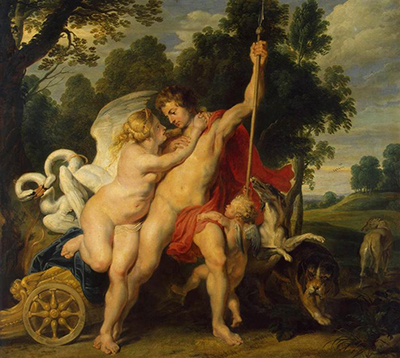Peter Paul Rubens produced multiple versions of the theme of Venus and Adonis, with this particular iteration being completed in 1614. It can be found in the Hermitage Museum in Russia.
It is believed that the artist also called upon the services of his studio in order to complete this large painting. We do know that Rubens himself formed the main figures and allowed others, such as Lucas van Uden or Jan Wildens to construct some of the less significant elements across the background. This method ensured that quality was assured in the main elements of the painting, whilst also freeing up the artist to work on other projects at the same time. This form of collaboration would also help to foster the abilities of his assistants over time and he increased their responsibilies as they proved themselves across different tasks. This painting was a part of a private collection in Brussels for around half a century before being sold directly to the Hermitage, where it has remained ever since.
This Flemish artist took good inspiration from Italian art of previous centuries, which had dominated most of the continent during that period. He would have been well aware of Titian's Venus and Adonis (1554) and probably took inspiration from that piece for his own work. Although from different backgrounds, Titian and Rubens both enjoyed a use of bright colour within their work, at least by the standards of more traditional art where most elements were relatively subdued in comparison to the new movements that appeared from the Romanticist era onwards towards the present day. Both were also accomplished in portraiture, making the theme of Venus and Adonis entirely appropriate for their respective oeuvres, and perhaps why they both produced several different versions of it.
Head to the Hermitage Museum in St Petersburg in order to view this beautiful artwork. This venue is an artwork in itself, with extraordinary architecture showing off an equally impressive collection. Several notable Russian collectors donated their possessions to the institution over a period of many years and together it forms probably the finest selection of art to be found within this country. This venue features a good array of European art, including major Italian, Spanish and Flemish artists. Goya, Antonio Canova and Diego Velazquez are just a few of the great names to look out for here, though in truth you could easily fill a period of several days journeying through the various rooms and buildings located on the river front in this delightful setting.




